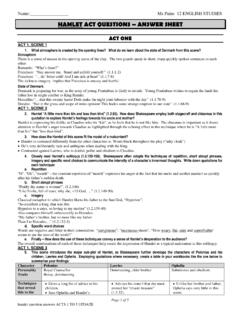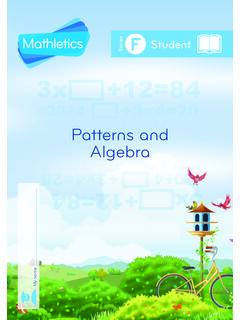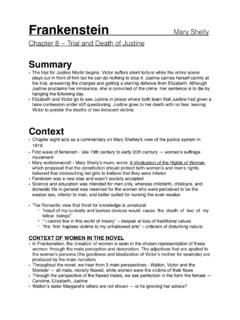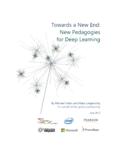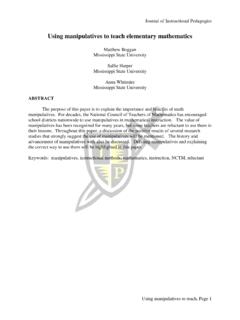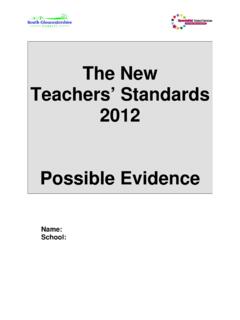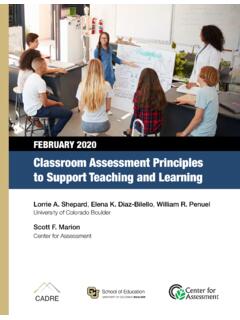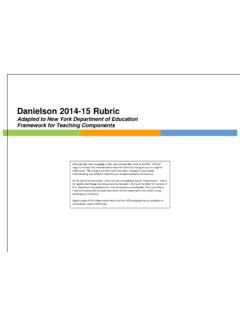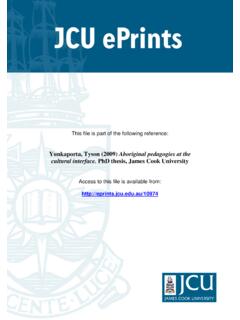Transcription of Learning Intentions and Success Criteria
1 CATHOLIC EDUCATION OFFICE MELBOURNEL earning Intentions and Success CriteriaCATHOLIC EDUCATION OFFICE MELBOURNEP ersonalised Learning at the intended level of the curriculum attends to student entitlements and optimises outcomes so that Learning is deliberate, targeted and relevant for individual learners. The intended curriculum is developmental enabling multiple entry points and allows for the local context whilst responding to system frameworks. Personalised Learning at the enacted level is the individual school s response to the intended curriculum based on deep knowledge of the student, the Learning continuum (all areas) and professional practice reflecting agreed contemporary pedagogies . It incorporates structures to include student voice in the Learning at the achieved level is the attainment of each student s Learning Intentions based on Success Criteria and feedback that enables future Learning and ensures progress over time.
2 CATHOLIC EDUCATION OFFICE MELBOURNECATHOLIC EDUCATION OFFICE MELBOURNEL earning IntentionsTo build our understanding and ability to develop quality Learning Intentions and Success Criteria for improved student outcomes. CATHOLIC EDUCATION OFFICE MELBOURNEH attie and Timperley(2007) describe three questions that guide Learning for students: Where am I going? ( Learning Intentions )How am I going? ( Success Criteria )Where to next? (Feedback)CATHOLIC EDUCATION OFFICE MELBOURNEW here am I going? ( Learning Intentions )CATHOLIC EDUCATION OFFICE MELBOURNESo what are they? Learning Intentions are brief statements that explicitly describe what students should know,understandand be able to do as a result of the Learning and EDUCATION OFFICE MELBOURNEK nowing where learners need to go:What we will be learningrather than what we will be doingCATHOLIC EDUCATION OFFICE MELBOURNEK nowing where learners need to go The importance of tuning in building on where learners are in their Learning Setting the scene why are we Learning this Explain the situation Linking to what is known Unfamiliar words and phrases are explainedCATHOLIC EDUCATION OFFICE MELBOURNEWhen students know the Learning Focus on the purpose of the activity Know where to focus their efforts More likely to stay on task Take responsibility for EDUCATION OFFICE MELBOURNEL earning Goals & Success Criteria , Ontario 2010 CATHOLIC EDUCATION OFFICE MELBOURNEHow do you write them?
3 Learning Intentions should relate to what the students will learn rather than what they will do. Learning Intentions should be written in student friendly language, in a way that actively engages students in the Learning EDUCATION OFFICE MELBOURNE Writing the Learning goals from the student s perspective ( We are Learning ) supports students in taking ownership of the Learning while simultaneously helping to make the Learning more explicit. Learning goals can be developed with students orally, visually or in writing, however displaying long term goals can act as a reference point for students as they monitor, reflect on and self assess their progress. Teachers should continually help students clarify their understanding of Learning goals throughout the duration of their Learning EDUCATION OFFICE MELBOURNEQ uestioning strategies How are you progressing towards toward your Learning intention?
4 How do you know? What helped you to progress towards your goal? How did your Learning connect with what you already knew and could do? CATHOLIC EDUCATION OFFICE MELBOURNEE xamples of Learning Intentions Learning Intentions that focus on knowledge Learning Intentions that focus on skills Learning Intentions that focus on understanding What do we what students to know, understand and do?CATHOLIC EDUCATION OFFICE MELBOURNEL earning Intentions that focus on knowledge Knowledge abouta particular topic Knowledge of howsomething is done Knowledge of whysomething happens Knowledge of whatcauses something to happenCATHOLIC EDUCATION OFFICE MELBOURNEL earning Intentions that focus on skillsStart with the words to be able to Imply the acquisition of certain knowledge or understandingsCATHOLIC EDUCATION OFFICE MELBOURNEL earning Intentions that focus on understandingUnderstanding builds on knowledge and requires some kind of processing.
5 Understanding is of a higher cognitive order than knowledgeCATHOLIC EDUCATION OFFICE MELBOURNEL earning IntentionsTypeFocusLengthLong CycleAcross periods, quarters, semesters, years4 weeks to 1 yearMedium CycleWithin and between units 1 4 weeksShortcycle: Within and between lessonsDay by dayMinute by minute24 to 48 hoursUp to 2 hoursWiliamand Thompson (2007)CATHOLIC EDUCATION OFFICE MELBOURNEG etting Learning Intentions rightMuddled Learning intentionClarified Learning intentionContextTo list what a pet needs to remain healthyTo be able to make a listA healthy petTo use multiplication grid with two digit numbersTo be able to use a multiplication gridA range of two digit numbersCATHOLIC EDUCATION OFFICE MELBOURNEL earning Intentions : what students thought they were Learning (Clarke 2005) Learning intention with contextWhat students thoughtthey were learningLearning intention without contextWhat students thought they were Learning nowTo write instructions to make a sandwich I would learn to make a sandwich To write instructions.
6 (A sandwich) We would be Learning to write instructions .Clarke, S. (2005) Formative Assessment in Action: weaving the elements together CATHOLIC EDUCATION OFFICE MELBOURNEHow am I going? ( Success Criteria )CATHOLIC EDUCATION OFFICE MELBOURNES uccesscriteriaSuccess Criteria describe, in specific terms and in language meaningful to students, what successful attainment of the Learning Intentions looks like. Criteria help students understand what to look for during the Learning . Quality Success Criteria makes the Learning explicit and transparent for students and teachers alike. They identify the significant aspects of student performance that are assessed and/or evaluated in relation to expectations. CATHOLIC EDUCATION OFFICE MELBOURNEWhat are they? .. Success Criteria summarisethe key steps or the ingredients the student needs in order to fulfill the Learning intention the main things to do, include or focus on.
7 -Shirley ClarkeCATHOLIC EDUCATION OFFICE MELBOURNEWhy are they important?How do we know we have met the Learning intention?When Success Criteria is used. The Learning becomes more explicit. Students can confirm, consolidate and integrate new knowledge. Future Learning is scaffolded. Students can see what quality looks like. Encourage independent Learning Enable accurate feedback CATHOLIC EDUCATION OFFICE MELBOURNEE ffective Success Arelinked to the Learning intention Are specific to an activity Are discussed and agreed with pupils prior to undertaking the activity Provide a scaffoldand focus for pupils while engaged in the activity Are used as the basis for feedbackand peer/self assessmentCATHOLIC EDUCATION OFFICE MELBOURNEE xample Learning intention: We are Learning to write a : Write a ghost storyI will be successful if : People enjoy reading my story and it frightens them Set the scene in the opening paragraph Buildup tension and suspense Use spooky adjectives and powerful verbs End the story with a cliffhangerCATHOLIC EDUCATION OFFICE MELBOURNE Process Criteria is more powerful than product Success Criteria Need to plan Success Criteria in advance Identifying Success Criteria leads to more focused Learning Success Criteria should be gathered from children to give them ownershipCATHOLIC EDUCATION OFFICE MELBOURNEA spects of assessment of learningIn order to provide a comprehensive framework Wiliamand Thompson (2007) proposed three processes were central: Establishing where the learners are in their learningEstablishing where they are goingEstablishing how to get EDUCATION OFFICE MELBOURNEW here is the learner going?
8 Where the learner is right now?How to get thereTeacherClarifying and sharing Learning Intentions and Criteria for successEngineering effective classroom discussion, questions, activities and tasks that elicit evidence of learningProviding feedback that moves learners forwardPeerUnderstanding and sharing Learning Intentions and Criteria for successActivating students as instructional resources for one anotherLearnerUnderstanding Learning Intentions and Criteria for successActivating students as the owners of their learningAspects of assessment of learningCATHOLIC EDUCATION OFFICE MELBOURNET eachers Clear Learning Intentions Challenging Success Criteria Range of Learning strategies Know when students are not progressing Providing feedbackCATHOLIC EDUCATION OFFICE MELBOURNES tudents Understanding Learning Intentions Are challenged by Success Criteria Develop a range of Learning strategies Know when they are not progressing Seek feedback Visibly teach themselvesCATHOLIC EDUCATION OFFICE MELBOURNEB enefits for StudentsChildren are more focused and interested.
9 Creating a positive Learning culture. Their self esteem is improving. We have given children the vocabto discuss their own workSuccess can now be achieved by allPupils are beginning to talk more about how they are Learning rather than what they are learningCATHOLIC EDUCATION OFFICE MELBOURNEB enefits for teachersI m more sensitive and atunedto individuals needs and achievementsSharing Learning Intentions and Success Criteria at the beginning of the lessons has resulted in teacher and pupils working more in partnership towards a common goalRelationships between teacher and pupils are warmer and positiveMy planning is more effective/focused/ and thoughtfulCATHOLIC EDUCATION OFFICE MELBOURNECATHOLIC EDUCATION OFFICE MELBOURNECATHOLIC EDUCATION OFFICE MELBOURNECATHOLIC EDUCATION OFFICE MELBOURNECATHOLIC EDUCATION OFFICE MELBOURNER esearchersJohn EDUCATION OFFICE MELBOURNEW here to now?
10 Spend some time on school blog Have a go at creating some Learning Intentions and Success Criteria -maybe these can be shared at our Celebrating Success PLT in Week 9 of term

